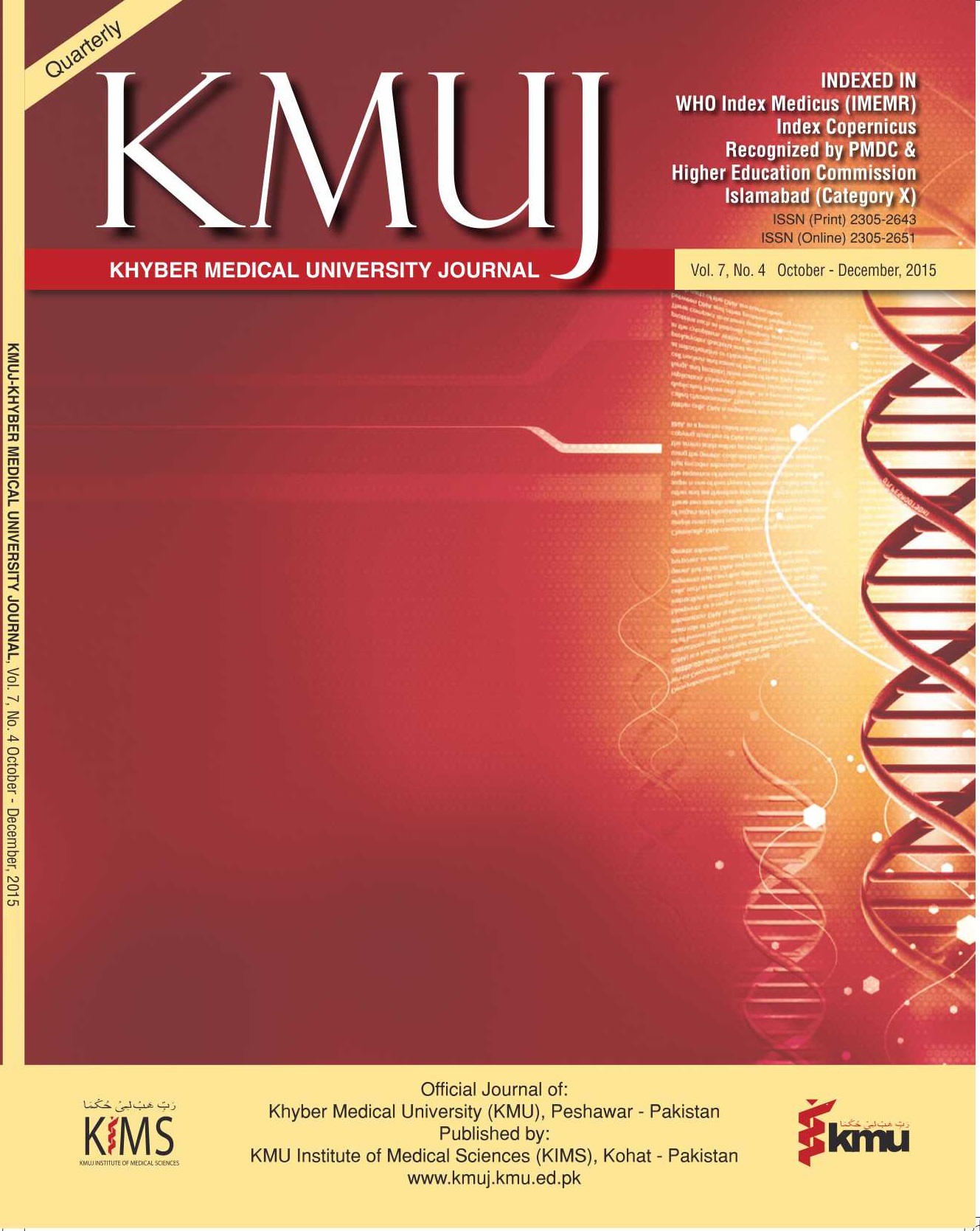HYPOVITAMINOSIS D IN HEALTHY STUDENTS OF A MEDICAL COLLEGE
Main Article Content
Abstract
OBJECTIVE: To determine the degree of hypovitaminosis D in healthy medical college students.
METHODS: This institution based cross-sectional study was conducted at Peshawar Medical College, Peshawar. One hundred and four healthy students were included in the study. Those who were taking vitamin D supplements, having any chronic disorder or having signs and symptoms of vitamin D deficiency were excluded from the study. A semi structured questionnaire was administered to all the participants to know about their demographic details, daily milk consumption and approximate duration of daily sunlight exposure. Five milliliter of blood was collected from the participants for determination of vitamin D levels.
RESULTS: The mean age of the sample was 23.26+0.98. There were 65 (62.5%) girls and 39 (37.5%) boys. The mean vitamin D level was 11.88±0.41 ngm/mL in male and 10.02±0.42 ngm/mL in female students. Vitamin D deficiency was observed in 99 (95.19%) cases. A total of 3(2.88%) students had mild deficiency, 19 (18.26%) were having moderate deficiency, and 77(74%) were having severe deficiency. Regarding the daily milk consumption, 70 (67.30%) students didn’t consume even a single cup of milk per day & 29(27.88%) used to take 1 cup of milk per day. Sun exposure of >120 minutes was observed in 84.6% of boys and 12.3% of girls and <60 minutes was observed in 55.4% of girls & 5.2% of boys.
CONCLUSION: Vitamin D deficiency is highly prevalent among healthy medical college students. The main contributing factors are low dietary intake of vitamin D and limited sunlight exposure.
EY WORDS: Vitamin D Deficiency (MeSH), Adolescent (MeSH), Medical Student (MeSH)
Article Details
Work published in KMUJ is licensed under a
Creative Commons Attribution 4.0 License
Authors are permitted and encouraged to post their work online (e.g., in institutional repositories or on their website) prior to and during the submission process, as it can lead to productive exchanges, as well as earlier and greater citation of published work.
(e.g., in institutional repositories or on their website) prior to and during the submission process, as it can lead to productive exchanges, as well as earlier and greater citation of published work.
References
Holick MF. Vitamin D: a millennium perspective. J Cell Biochem 2003;88:296- 307.
Giovannucci E. The epidemiology of vitamin D and cancer incidence and mortality: a review (United States). Cancer Causes Control 2005; 16:83–95.
Holick MF. Vitamin D: important for prevention of osteoporosis, cardiovascular heart disease, type 1 diabetes, autoimmune diseases, and some cancers. South Med J 2005; 98:1024–7.
Petifor JM, Daniels ED. Vitamin D deficiency and nutritional rickets in children. In: Feldman D, Glorieux FH, Pike WJ, eds. Vitamin D. San Diego, CA: Academic Press; 1997:13–32
Ray AJ, Meikle AW, D Light: Vitamin D and good health. MLO [Med Lab Obs]. 2010; 32: 32-7.
Baig A, Anjum P, Khani MK, Islam N, Rehman A. Pattern of serum vitamin D in OPD patients. Pak J Surg 2007; 23: 145-9.
Javed R, Malik SY, Yaqub S, Ghafoor F, Asim M. Levels of 25-OH Vitamin D in Healthy Asymptomatic Adults: Pilot Study. Pak J Med Res. 2012; 51(3):82-7.
Mahmood K, Akhtar ST, Talib A, Haider I. Vitamin-D status in a population of Healthy adults in Pakistan. Pak J Med Sci 2009; 25(4):545-50.
Hashemipour S, Larijani B, Adibi H, Javadi E, Sedaghat M, Pajouhi M. Vitamin D deficiency and causative factors in the population of Tehran. BMC Public Health 2004; 4(1):38.
Du X, Greenfield H, Fraser DR. Vitamin D deficiency and associated factors in adolescent girl in Beijing. Am J Clin Nutr 2001; 74:494-500.
Alagol F, Shihadeh Y, Boztepe H. Sunlight exposure and vitamin D in Turkish women. J Endocrinol Invest 2000; 23: 173-77.
Gannage-Yared MH, Chemali R, Yaacoub N, Halaby G. Hypovitaminosis D in a sunny country: relation to lifestyle and bone markers. J Bone Miner Res 2000; 15:1856–62.
Zargar AH, Ahmad S, Masoodi SR, Wani AI, Bashir MI, et al. Vitamin D status in apparently healthy adults in Kashmir Valley of Indian subcontinent. Postgrad Med J 2007; 83; 713-16.
Mishal AA. Effects of different dress styles on vitamin D levels in healthy young Jordanian women. Osteoporos Int 2001; 12:931-35.
Hatun S, Islam O, Cizmecioglu F, Kara B, Babaoglu K, Berk F, et al. Sub clinical vitamin D deficiency is increased in adolescent girls who wear concealing clothing. Am Soc Nutr Sci2005; 135: 218 –22.
Das G, Crocombe S, McGrath M, Berry JL & Mughal MZ. Hypovitaminosis D among healthy adolescent girls attending an inner city school. Arch Dis Child 2006; 91: 569 –72.
Puri S, Marwaha RK, Agarwal N, Tandon N, Agarwal R, et al. Vitamin D status of apparently healthy schoolgirls from two different socioeconomic strata in Delhi: relation to nutrition and lifestyle. Br J of Nutr 2008; 99: 876–82.
Juzeniene A, Moan J. Beneficial effects of UV radiation other than via vitamin D production. Dermatoendocrinol. 2012;4(2):109–17.
